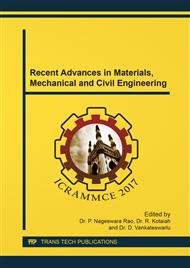p.3
p.13
p.20
p.26
p.33
p.39
p.44
p.50
Effect of FSP on Strength and Fracture Toughness of Aluminium Alloy 7000
Abstract:
The cast Al-Zn-Mg 7000 alloy has become one of the most potential structural materials in many engineering fields such as aircraft body, automotive casting due to their high strength to weight ratio, strong age hardening ability, competitive weight savings, attractive mechanical properties and improvement of thermal properties. The cast aluminium alloy has been modified of surface layer through a solid-state technique is called friction stir process (FSP). But basic principle has been followed by friction stir welding (FSW). This process can be used to locally refine microstructures and eliminate casting defects in selected locations, where mechanical properties improvements can enhance component performance and service life. However, some specified process parameters have adopted during experimental works. Those parameters are tool rotation speed (720 rpm), plate traverse speed (80 mm/min), axial force (15 kN), and tool design (i.e., pin height 3.5 mm and pin diameter 3.0 mm), respectively. The main mechanism behind this process likely to axial force and frictional force acting between the tool shoulder and workpiece results in intense heat generation and plastically soften the process material. The specified ratio of rotational speed (720 rpm) to traverse speed (80 mm/min) is considered 9 as low heat input during FSP and its entails low Zn vaporization problem results as higher fracture toughness of aluminium alloy. It is well known that the stirred zone (SZ) consists of refine equiaxed grains produced due to dynamic recrystallization. FSP has been proven to innovatively enhancing of various properties such as formability, hardness and fracture toughness (32.60 MPa√m). The hardness and fracture toughness of double passes AC+FSP aluminium alloy had been investigated by performing Vicker’s hardness measurement and fracture toughness (KIC)(ASTM E-399 standard) tests. Detailed observations with optical microscopy, Vicker’s hardness measurement, SEM, TEM, and DTA analysis have conducted to analyse microstructure and fracture surfaces of double passes FSP aluminium alloy.
Info:
Periodical:
Pages:
20-25
Citation:
Online since:
February 2018
Authors:
Price:
Сopyright:
© 2018 Trans Tech Publications Ltd. All Rights Reserved
Share:
Citation:


